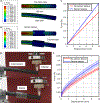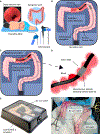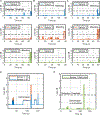Ex Vivo Evaluation of a Soft Optical Blood Sensor for Colonoscopy
- PMID: 39678941
- PMCID: PMC11637413
- DOI: 10.1016/j.device.2024.100422
Ex Vivo Evaluation of a Soft Optical Blood Sensor for Colonoscopy
Abstract
Colonoscopies are vital procedures allowing diagnosis of colorectal cancer and other gastrointestinal diseases. However, excessive forces may be applied to the colon during navigation. This can cause bleeding, especially in patients presenting inflammatory bowel diseases. The endoscopist is often unable to detect bleeding as visualization is limited to the distal tip camera of the endoscope. Thus, there is a need to have bleeding detection capabilities behind the device tip. This work presents a soft optical blood sensor that can be mounted onto a colonoscope. The presence of blood in the sensor's microchannel causes a reduction in optical transmission, and the endoscopist is alerted. We evaluate the sensor safety and performance ex vivo with a cohort of 10 endoscopists (novices and experts). We demonstrate the ability of the sensor to rapidly identify bleeding and easily integrate into the clinical workflow, without significantly affecting navigation time and the users' learning curve.
Keywords: Colonoscopy; Ex Vivo; Minimally Invasive Surgery; Soft Robotics; Soft Sensing.
Conflict of interest statement
Declaration of Interests Max McCandless is currently a post-doctoral researcher at Boston Children’s Hospital, Harvard University. His contributions in this paper were from his tenure as a PhD student at the Material Robotics Laboratory, Boston University (affiliation as declared on the manuscript).
Figures











References
-
- Chhikara BS and Parang K (2023). Global Cancer Statistics 2022: the trends projection analysis. Chemical Biology Letters 10, 451.
Grants and funding
LinkOut - more resources
Full Text Sources
